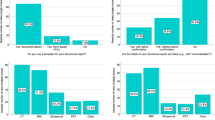Abstract
Purpose
Interactions between radiologists and emergency physicians are often diminished as imaging volume increases and more radiologists read off site. We explore how several commonly used phrasings are perceived by radiologists and emergency physicians to decrease ambiguity in reporting.
Methods
An anonymous survey was distributed to attendings and residents at seven academic radiology and emergency departments across the USA via a digital platform as well as to an email group consisting of radiologists across the country with an interest in quality assurance. Physicians were asked to assign a percent score to probabilistic phrases such as, “suspicious of,” or “concerned for.” Additional questions including, “how often the report findings are reviewed,” “what makes a good radiology report,” and “when is it useful to use the phrase ‘clinical correlation are recommended.’” Median scores and confidence intervals were compared using an independent Student’s T-test.
Results
Generally, there was agreement between radiologists and emergency room physicians in how they interpret probabilistic phrases except for the phrases, “compatible with,” and “subcentimeter liver lesions too small to characterize.” Radiologists consider a useful report to answer the clinical question, be concise, and well organized. Emergency physicians consider a useful report to be concise, definitive or include a differential diagnosis, answer the clinical question, and recommend a next step. Radiologists and emergency physicians did not agree on the usefulness of the phrase, “clinical correlation recommended,” in which radiologists found the phrase more helpful under particular circumstances.
Conclusion
The survey demonstrated a wide range of answers for probabilistic phrases for both radiologists and emergency physicians. While the medians and means of the two groups were often different by statistical significance, the actual percent difference was minor. These wide range of answers suggest that use of probabilistic phrases may sometimes lead to misinterpretation between radiologist and emergency room physician and should be avoided or defined if possible.









Similar content being viewed by others
Data availability
Available.
Code availability
Not applicable.
References
Reiner B et al (1999) Impact of filmless radiology on frequency of clinician consultations with radiologists. AJR Am J Roentgenol 173(5):1169–1172
Berlin L (2000) Pitfalls of the vague radiology report. AJR Am J Roentgenol 174(6):1511–1518
Dunnick NR, Langlotz CP (2008) The radiology report of the future: a summary of the 2007 Intersociety Conference. J Am Coll Radiol 5(5):626–629
Panicek DM, Hricak H (2016) How Sure Are You, Doctor? A standardized lexicon to describe the radiologist’s level of certainty. AJR Am J Roentgenol 207(1):2–3
Selvarajan SK, Levin DC, Parker L (2019) The increasing use of emergency department imaging in the united states: is it appropriate? AJR Am J Roentgenol 213(4):W180–W184
Grant MD et al (2021) Are we speaking the same language? Communicating diagnostic probability in the radiology report. AJR Am J Roentgenol 216(3):806–811
Blagev DP et al (2014) Follow-up of incidental pulmonary nodules and the radiology report. J Am Coll Radiol 11(4):378–383
Khalil HI, Patterson SA, Panicek DM (2005) Hepatic lesions deemed too small to characterize at CT: prevalence and importance in women with breast cancer. Radiology 235(3):872–878
Author information
Authors and Affiliations
Contributions
None.
Corresponding author
Ethics declarations
Ethics approval
Institutional Review Board (IRB) approved.
Competing interests
The authors declare that they have no conflict of interest.
Additional information
Publisher's note
Springer Nature remains neutral with regard to jurisdictional claims in published maps and institutional affiliations.
Rights and permissions
About this article
Cite this article
Ogawa, M., Lee, CH. & Friedman, B. Multicenter survey clarifying phrases in emergency radiology reports. Emerg Radiol 29, 855–862 (2022). https://doi.org/10.1007/s10140-022-02057-x
Received:
Accepted:
Published:
Issue Date:
DOI: https://doi.org/10.1007/s10140-022-02057-x




